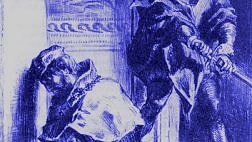 CHECK OUT YOUR FREE
CHECK OUT YOUR FREE
SAMPLE ESSAY BELOW

Check out your free
sample essay below

Essay introduction /
Thesis statement
“I shall win at the odds”
One of the reasons why Hamlet is Shakespeare’s longest play is that its title character Prince Hamlet talks so much. Yet no one in drama has revealed so little of himself while saying such a lot.
Like his creator, Hamlet is an actor (“I perchance hereafter shall … To put an antic disposition on”, 1.5) and a playwright (“The play’s the thing / Wherein I’ll catch the conscience of the king” , 2.2). Yet the prince faces such “a sea of troubles” (3.1) that by the second scene he wishes he could write himself out of the drama in which the Shakespeare has cast him—“How weary / His law ’gainst self slaughter” (1.2).
The “Who’s there?” question posed in the opening line is one the prince asks of himself all through the play and audiences have wondered about ever since. Who is Hamlet? And does he “win at the odds” (5.2)?
SHARE THE SHAKESPEARE
#Hamlet: Born a prince, parented by a jester, haunted by a ghost.
1
Hamlet: Revenge and forgiveness
“Alas, poor ghost!”
We, the audience, hear Claudius’ confession (“O heavy burden!”, 3.1). But what if, like Hamlet, we had not? What would we do? Lacking certain knowledge, no amount of “thinking too precisely on th’ event” (4.4) helps Hamlet, a man of reason, to reason his way to a solution. He “cudgels” his “brains” (5.2) in vain.
For Christians, vengeance belonged only to God, but as Hamlet asks Horatio, might a Christian not also “in perfect conscience” take a life to prevent “further evil” (5.2)?
In the end, Hamlet is both killed and forgiven by Laertes, the avenger Hamlet’s desire for revenge created. And he surrenders Denmark to the son of the man his own father slew and whose lands he took on the day the prince was born. By so doing, he atones for Old King Hamlet’s sins and grants peace to his restless, “doomed … to walk the night” spirit (1.5).
SHARE THE SHAKESPEARE
#Hamlet grants his father not the revenge he demanded but the atonement his suffering soul needed more.
2
Hamlet’s madness
“Losing his wits … here in Denmark”
“But break, my heart, for I must hold my tongue”, the anguished prince declares in 1.2. When he decides shortly afterward to put on an “antic disposition” (1.5), it is at least in part because such a talkative figure cannot remain silent for very long. What the king calls his “turbulent and dangerous lunacy” (3.1) provides a convenient license for his Elsinore-confined nephew to vent his rage and despair.
Hamlet’s pretend madness not only helps him to cling to his sanity; it also helps save his life. The prince’s foolery with Polonius’ dead body is a shrewd theatrical performance intended to avoid immediate execution for a crime later described by Laertes as “so capital in nature” (4.7).
Although described by Claudius as “free from all contriving” (4.7), the “I know not seems” (1.2) Hamlet is the play’s most contriving character.
SHARE THE SHAKESPEARE
"How came he mad?" - #Hamlet asks about himself to the grave-digger.
3
Hamlet: acceptance or action?
“To be or not to be”
In his “To be or not to be—that is the question” soliloquy of 3.1, Hamlet generalizes his particular circumstances into a universal and timeless dilemma. For its concerns trouble every “fellow … crawling between earth and heaven” (3.1)
Is it “nobler in the mind” to rather “bear those ills we have / Than fly to others that we know not of?” Should we endure the world as it is, with all the “slings and arrows”? Or should we take on “a sea of troubles” by seeking to change the world for the better? For doing so may imperil more than our lives; it may also damn our souls if we are tempted into committing a wrong to achieve a rightful goal.
It is a soliloquy that ends without a conclusion, but also one that begins without a question mark.
SHARE THE SHAKESPEARE
#Hamlet's "To be or not to be" (3.1): Ends without a conclusion; begins without a question mark.
4
Hamlet: tragic hero or player prince?
“Who’s there?”
Claudius, Gertrude and Laertes are all doomed by their own faults. But Prince Hamlet seems less a tragic hero than a reluctant figure in a tragedy of fate rather than a tragedy of character. In the king’s words: “He cannot choose but fall” (4.7).
That the prince was born on the same day that Fortinbras lost his father and Elsinore’s clownish gravedigger began his work suggests that the play’s ending is the unfolding of an inevitable destiny.
Fate never allowed the prince to follow the fatherly advice received by Laertes: “To thine own self be true” (2.2). His one moment of playing “Hamlet the Dane” (5.1) is when he uses his father’s signature and seal on board ship—an ironic moment of authentic forgery when the title character of a play filled with play-acting impersonates himself.
SHARE THE SHAKESPEARE
#Hamlet - A play-long pun on the verb 'to act': to do and to play a false role.
5
Essay conclusion / Summary
“Remember me”
Prince Hamlet ends the play much as Old King Hamlet began it: as a ghost, suspended between this world and the next, fearing his life will be forgotten and the truth forever hidden. “Remember me” (1.5), asked the father; “Report me and my cause aright” (5.2), pleads the son.
Whereas the Ghost demanded remembrance in the form of revenge, all Prince Hamlet asks of Horatio is that his story is told. For the “wounded name” the prince leaves behind of “he that is mad and sent into England” (5.1) is an incomplete version of his tragic tale: of a prince who, like Yorick, was “a fellow of infinite jest and most excellent fancy” (5.1), but who was also destined to kill a king rather than become one.
SHARE THE SHAKESPEARE
#Hamlet does "win at the odds"; usurper, justly killed (Claudius): soul, forgiven (Laertes); story, told (Horatio).
6
The most helpful book ever for students and teachers of Shakespeare’s Hamlet.
42 x 1,500-word model essays

Chapter-by-chapter guide to Hamlet Model Essays
IN THIS BOOK ARE THREE 1,500-WORD SAMPLE ESSAYS ON EACH ONE OF THE FOLLOWING 14 CHARACTERS, RELATIONSHIPS, AND THEMES. THAT’S 42 SAMPLE ESSAYS IN TOTAL.

#1: The Character of Hamlet
Born a prince, parented by a jester, haunted by a ghost, destined to be killed for killing a king, and remembered as the title character of a play he did not want to be in. If at the cost of his life, Hamlet does in the end “win at the odds.”

#2: The Character of Claudius
His “ambition” for Denmark’s crown leads him to commit one murder only to find that he must plot a second to cover up the first. When this plan fails, his next scheme leads to the death of the woman he loves followed by his own.

#3: The Character of Gertrude
“Have you eyes?”, Prince Hamlet demands of his mother. Gertrude‘s “o’erhasty marriage” dooms her life and the lives of everyone around her when her wished-for, happy-ever-after fairytale ends in a bloodbath.

#4: The Character of Ophelia
As she struggles to respond to the self-serving purposes of others, Ophelia’s sanity collapses in Elsinore’s “unweeded garden” of falsity and betrayal. Her “self-slaughter” is her revenge for her silencing and humiliation.

#5: Relationship of Hamlet and the Ghost
Hamlet grants the Ghost the atonement his suffering soul needed more than the revenge he demanded: he surrenders Denmark to the son of the man murdered by his father on the day of the prince’s birth.

#6: Relationship of Hamlet and Claudius
Uncle and nephew are two men at war with each other—and themselves. Claudius is haunted by the murder he has committed (“O heavy burden!”); Hamlet by the one he hasn’t yet (“Am I a coward?”).

#7: Relationship of Hamlet and Gertrude
A haunted-by-the-past Hamlet seeks the truth about his father’s death (“Do you see nothing there?”). A live-in-the-present Gertrude seeks to protect her second husband and crown (“No, nothing but ourselves”).

#8: Relationship of Hamlet and Ophelia
Their relationship begins in uncertainty, descends into mutual deceit and rejection, and ends with their double surrender to death: Ophelia, to the water; Hamlet, to Claudius’ rigged fencing duel.

#9: Relationship of Hamlet and Horatio
“Those friends thou hast … Grapple them unto thy soul with hoops of steel.” Horatio is Hamlet’s trusted confidant in life and vows to remain the keeper of his memory after the prince’s death.

#10: Relationship of Claudius and Gertrude
A marriage of mutual self-interest: Claudius wanted to become king; Gertrude wanted to remain queen. In the end, both die by the same poison her second husband used to murder her first.

#11: Main Themes of Hamlet
A king murdered, an inheritance stolen, a family divided: Elsinore’s older generation destroys its younger when two brothers—one living, one undead—battle in a “cursed spite” over a crown and a queen.

#12: The Theme of Revenge
Hamlet and Laertes journey from revenge, through obsession and anger, to forgiveness. And the revenge sought by the Ghost on King Claudius becomes the revenge of Old King Fortinbras on Old King Hamlet.

#13: Deception and Appearance versus Reality
“Who’s there?” The characters struggle to distinguish between truth and falsehood in a play-long triple pun on the verb ‘to act’: to take action, to behave deceitfully, and to perform in theater.

#14: The Theme of Madness
“Your noble son is mad”, Polonius tells Denmark’s king and queen. But is Hamlet ever really insane? If not, why is he pretending to be? And is the prince’s “antic disposition” the cause of Ophelia’s traumatic breakdown?
















